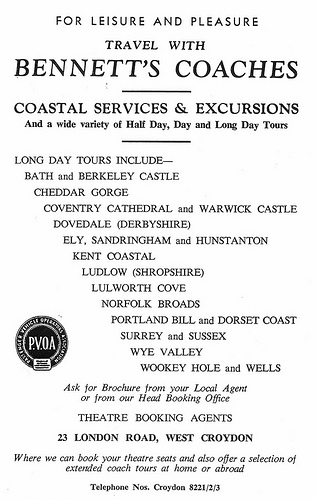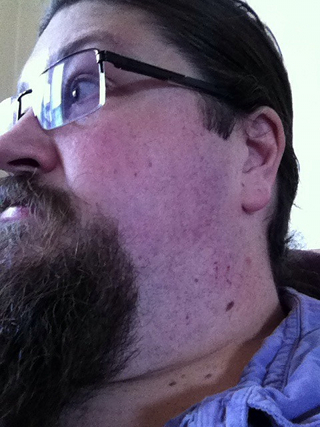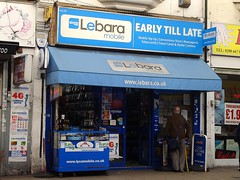23 London Road is the home of Prestige Barber. This is one of the smaller shopfronts on London Road, being a mere 3¼ metres across.[1]
1860s–1870s: Construction of the building, and Alfred James Potter, bootmaker
The building was constructed around 1869–1872, at the same time as numbers 25, 27, and 29.[2] These four properties were built in the same style as number 21, though the latter was actually built several years earlier at the same time as the quite different-looking properties at numbers 13–19.
The first occupant of number 23 was a bootmaker called Alfred James Potter.[3] Born in the Berkshire village of Cookham, Alfred James Potter was in Croydon by 1861, living on Parsons Mead and working as a journeyman “boot closer”.[4] He was only 26 at this point, but already had a 20-year-old apprentice, Charles Sadler. By 1871 he was living on Waddon New Road and had progressed to being described as a “bootmaker employing 4 men”.[5] If he brought these four men with him to London Road, it must have been a fairly tight fit in this very narrow property.
1870s–1880s: William Creak, fancy draper
Alfred James Potter continued to make boots on London Road until the end of the 1870s, when he moved to Derby Road[6] and was replaced by William Creak, fancy draper.[7] William Creak had been operating as a draper at 29 London Road over the eight or so years since these properties were built, and presumably felt he was doing well enough to open a second shop at number 23. However, by 1882 he had left London Road altogether. Number 29 passed into the hands of another draper, Charles W Chapman, while number 23 was taken over by W Woolston, tobacconist.[8]
1880s–1920s: A series of tobacconists
Although W Woolston only remained at the property for a year or two, his choice of goods proved to be a highly suitable one for the premises; it would continue as a tobacconists under various ownership for the next half-century. Taking over from W Woolston was Herbert Rowling, listed in street directories from 1884 to 1895 inclusive. He was followed in turn by P G Crow (1896–1903), Allsop & Wagner (1904–1908), and finally W Pritchard (1909–1930).[9]

1930s–1960s: John Bennett coaches
The next type of business conducted at 23 London Road was also a long-lived one. John Bennett moved his motor coach business from 1 Drummond Road to 19 London Road in mid-1925, but by 1932 he’d moved again, a couple of doors up to number 23.[10] It’s possible that the reason for this second move was the relative sizes (and hence rents) of the two properties — perhaps number 19 was larger than necessary for a booking office that had no need for space to display goods or store stock.
Around the same time as the move to number 23, John Bennett took delivery of eleven new Leyland coaches, all with the very latest chassis design: the Leyland Tiger TS4, which had been introduced at the Commercial Motor Show of the previous year. The 32-seater coach bodies, built by Thomas Harrington Limited of Hove, Sussex, used a brown and cream livery. The simple, clean design of the coaches must have looked quite appealing to the public of the time, as photographs or drawings of the new fleet were used to illustrate John Bennett’s timetable leaflets through most of the 1930s.[11]
These coaches were used for all kinds of excursions, including express services to the coast in summer, departing from Mead Place at 9:15am for destinations such as Bognor Regis, Brighton, Clacton, Margate, Southsea, and more.[12] According to an advertisement in the Croydon Official Guide 1963, John Bennett’s coach tours for that year offered “coastal services & excursions” as well as “a wide variety of Half Day, Day and Long Day Tours” with destinations including Cheddar Gorge, Coventry Cathedral, the Norfolk Broads, and Wookey Hole.
1960s–1970s: A Timpson & Sons, coach tours and travel agency
John Bennett (Croydon) Ltd ceased to trade in February 1958, but the licenses were passed on to an associated company, A Bennett & Sons Ltd. The coach tour business remained at 23 London Road under the name “John Bennett” until early 1966; at this point, it was acquired by A Timpson & Sons Ltd, who continued to offer coach tours and travel agency services at the same address until early 1975.[13]
Following the departure of Timpsons, the property remained empty for at least a year. Planning permission was granted in July 1976 for use of the upper floors as offices and the ground floor as a reception area — on condition that “[a] window display shall be provided and maintained [in order to] protect the visual amenities of the area” — but I haven’t been able to find out if this permission was actually taken up.[14]
1970s–1980s: The Spastics Society
On 25 October 1977, the Spastics Society was granted planning permission to use the ground floor of 23 London Road as a charity gift shop. In the application, the Society also stated its intention to use the upper floors of the building as administrative offices, since it was “decentralising from Central London”.[15]
The Spastics Society was formed in 1952 with the aim of equal educational rights for disabled children, and its first charity shop was opened in Sevenoaks in 1970. It’s still in existence today, though under a different name: Scope.[16] It also still has a London Road presence today, with a charity shop at number 3.
The shop at number 23 was open by late 1978[17] and continued to trade until late 1986, but in December of that year the Society was granted permission to change the ground floor of the building back to offices.[18]
I don’t know if the Society took advantage of this change of use itself; it’s possible that it was planning to move out, and had a new tenant in mind who wanted to use the whole building as an office, though this is just speculation on my part. In any case, the Society was gone from the ground floor by April 1987; the Goad plan for that month shows the premises as “Temp (Colliers, Bigwood & Bewlay)”, suggesting some kind of temporary interim use.[19]
1990s: Stone Edwards and Taylor Willcocks
By March 1990 the property was being used by Stone Edwards, a firm of solicitors, and by April 1994 it had passed to another firm of solicitors, Taylor Willcocks.[20] I don’t know if Stone Edwards and Taylor Willcocks were related. Taylor Willcocks specialised in personal injury, housing, and family work, and held a Legal Aid Board franchise.[21]
By September 1999 the premises were once again vacant. I’m not sure how long this period of vacancy lasted, nor whether there was anything there in between Taylor Willcocks and Prestige Barber.[22]
2000s–present: Prestige Barber
Prestige Barber opened some time around 2003[23] and remains there today, providing haircutting and barbering services to the people of West Croydon. As my own efforts to grow facial hair have proved unfruitful, I sent a bearded collaborator along to sample their services earlier this year. His report in full is below.
“£5 for a wet shave. done with blade. machine was offered. done with just water and then aftershave. took under 5 minutes.”
Sounds nice and efficient to me!
Thanks to: Alan Cross; bob walker; Brian Gittings; John Bennett of Loughborough; Mr Khan at Prestige Barber; the Planning Technical Support Team at Croydon Council; all at the Croydon Local Studies Library; and my beta-readers Alice, Kat, and Steve. Census data and phone books consulted via Ancestry.co.uk.
Footnotes and references
- The frontage of 23 London Road on the 1896 town plans is 6.5mm, which at 1:500 scale corresponds to 3¼ metres. The narrowness of the ground-floor property is due to the fact that there’s a passageway leading through to the back of the premises which takes up around half of the footprint; the upper floors of the building are full-width.
- The 1868 Town Plans show that the land on which 23–29 would later be built was not developed at that point, other than being used as the grounds of a Congregational Chapel (see my article on 21 London Road for an excerpt of this map). In addition, street directories up to and including Warren’s 1869 all omit these properties from their listings. The first directory in which they appear is Wilkins’ 1872–3.
- As noted in footnote [2], the property now numbered as 23 London Road first appears in Wilkins’ 1872–3 directory; the occupant is A J Potter, bootmaker. Later directories (Ward’s 1874, Ward’s 1876, etc.) give his full name as Alfred James Potter.
- According to the Oxford English Dictionary (online version, accessed 12 January 2017), a boot closer is “one who sews together the upper leathers of boots”.
- Information on Alfred James Potter in 1861 and 1871 taken from the relevant censuses.
- The 1881 census lists Alfred James Potter and his family at 13 Derby Terrace, Derby Road. He’s still a bootmaker, now employing two men rather than four. The last street directory in which he appears on London Road is Atwood’s 1878.
- Ward’s 1880 directory lists William Creak, fancy draper, at the property.
- Information from Ward’s 1882 directory.
- Information from Ward’s street directories.
- An article on John Bennett in issue 47 of Leyland Torque, published by the Leyland Society and available as a PDF from the archived version of their website, says “the limited company [was] formed in 1926”, but notes that the firm “had origins in the days of solid-tyred charabancs, probably prior to the First World War”. The author of that article, John Bennett of Loughborough (no relation to the Croydon man of the same name) tells me that the source for this information is the Motor Transport Year Book & Directory of 1929–30, which states that John Bennett (Croydon) Limited was “Registered 10th August 1926. Formed to take over and to carry on a business of motor engineers, haulage contractors, motor coach proprietors, etc.” John Bennett, motor coach proprietor, is listed in London phone books at 8 High Street in April 1924, at 1 Drummond Road in October 1924 and April 1925, and at 19 London Road from October 1925 onwards. (He’s also listed as a haulage contractor at Thornton Road, Thornton Heath, and these entries are bracketed together so it’s clearly the same John Bennett.) Ward’s 1927 and 1928 directories list John Bennett at 19 London Road, omitting his profession, while the 1929 and 1930 editions list “Bennett John (Croy.) Ltd, Motor Coaches” (note that these directories listed the person’s surname first). Ward’s 1932 lists 19 London Road as unoccupied, and J Bennett (Croy. Ltd) at number 23.
- Information on these coaches taken from the Leyland Torque article mentioned in footnote [11].
- Information on Mead Place departures and destinations taken from the Leyland Torque article mentioned in footnote [11]. The author kindly provided the timetable image shown in my article, which confirms these details.
- Date that John Bennett (Croydon) Ltd ceased trading, information about the license passing to A Bennett & Sons Ltd, and information about the “John Bennett” name continuing to 1966 were all supplied by John Bennett of Loughborough. Acquisition by Timpsons also via John Bennett of Loughborough, backed up by an article in the Commercial Motor of 25 February 1966 which states that “Negotiations are taking place for the acquisition by A. Timpson and Sons Ltd. of [...] John Bennett (Croydon) Ltd. [...] it is hoped that the takeovers will be effected in time for Easter.” According to a planning application (ref 76-20-928) viewed on microfiche at Croydon Council offices, use of the “ground floor kiosk type shop” at 23 London Road as “a booking office for a coach hire business [...] ceased in early 1975”.
- Information in this paragraph taken from planning application 76-20-928, viewed on microfiche at Croydon Council offices. In addition to the quotation in footnote [13] above, this application states that as of May 1976 the property had been vacant for “approx 12 months”. The council officer’s report included in the file notes that “In view of the very restricted size of the shop its use as a reception for the offices above would seem reasonable. It is not in the best shopping area and alone would have no impact on the area. No changes proposed to shopfront although one would hope it would be smartened up.”
- Planning application 77-20-1503, viewed on microfiche at Croydon Council offices. Note that the stated intention to use the upper floors as offices was merely supporting information for the application — the Society had no need to apply for permission for this, since permission had been granted for office use on the first and second floors in July 1976.
- Date and aim of Spastics Society founding, and date and place of its first charity shop, are taken from the history page on the Scope website.
- Local phone books list “Spastics Society (Shops Dept)” at 23 London Road from November 1978 onwards. (The phone book preceding this one was for July 1977, before the Society was granted its planning permission, so it’s not surprising that it doesn’t appear there.) This isn’t proof that the shop was open at that point — it could have just been the offices — but the same wording is used in subsequent phone books up to and including May 1983, so it seems likely that it refers to the shop as well as the offices. The October 1984 Caterham & Reigate phone book lists it as “Spastics Society The, Shops, 23 London Road.” I don’t have access to post-1984 phone books.
- Planning application 86-3007-P, viewed on microfiche at Croydon Council offices. The application was deposited on 6 November 1986 and describes the present use of the ground floor as “shop for the sale of goods in aid of charity”.
- Colliers, Bigwood & Bewlay seems to have been a firm offering some kind of property-related services, but I haven’t been able to find out exactly what its involvement here was. When Goad plans list a property as “vacant”, they often include the name of an estate agent in parentheses, so perhaps that’s what’s going on here too.
- Stone Edwards is shown on the March 1990 and June 1992 Goad plans. Taylor Willcocks is shown on the April 1994 and June 1995 Goad plans.
- A advertisement feature — “Focus on the London Road” — on page 8 of the Croydon Advertiser of 3 March 1995 states that Taylor Willcocks was “one of the few Croydon firms to have gained a Legal Aid Board franchise” and that it provided “specialist quality service in person injury, housing and family work including emergency work in situations of violence”. More information on Legal Aid Board franchises at this time can be found in an October 1992 article in The Independent.
- The September 1999 and May 2002 Goad plans list the property as “vacant outlet”. I haven’t yet had a chance to look at other Goad plans from this period.
- Mr Khan, manager at Prestige Barber, told me in a conversation on 4 September 2013 that the business had been going for more than 10 years (and that it had always been called “Prestige Barber”).

![A-board reads: “Prestige Barbers / Hair cut (Mon-Thurs) £6.00 / Hair cut (Fri-Sun) £7.00 / Child (under 10 years) £5.00 / Wet shave £5.00 / Beard trim £3.00 / Wash cut b/dry £10.00 / Cut, colour & wash £18:00 [sic] / O.A.P Special (Tuesday only) £5.00 / Student (Thursday only) £5.00 / We also do new born baby head shave / Open 7 Days / Mon-Fri 9:00am-8:30pm Sat 8:00am-8:30pm Sun 9:00am-7:30pm”. A-board giving prices of various haircuts and shaves, as well as opening hours. The text is in white on a black background. A large red arrow at the bottom points toward the shop.](https://farm3.staticflickr.com/2814/9300520302_7d6614af72_n.jpg)



